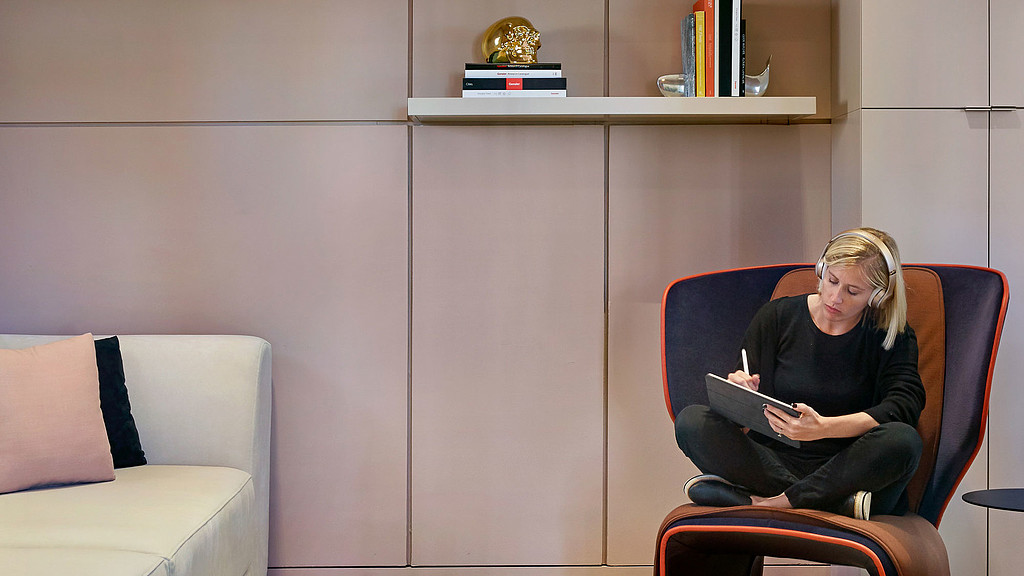Remote Working Offers an Opportunity to Experiment and Learn
By Janet Pogue McLaurin
Editor’s Note: This post is part of our ongoing exploration of how design is responding to the COVID-19 pandemic.
COVID-19 is disrupting our lives. Working from home is now a sudden reality. Whether you were in a routine of working at the office or a coworking site, most of us started to work from home this week. The conversation has now shifted from workplace wellness" to how to work virtually — and how to do so effectively.
U.S. workers prefer a well-designed office space over working from home. Place matters. So, how can we apply the best practices that make an effective corporate workplace, and instead create a great workplace at home?
Workstyle Factors: Gensler’s latest workplace research found that U.S. workers in companies of 100 people or more, spend 14% of their time collaborating virtually. That’s about to change. Working from home demands a new workstyle and tempo — one that balances the need to serve your clients, collaborate with teams virtually, stay connected to colleagues, and carve out time for focused individual work. Parents have the added pressure of trying to work with kids who are home from school or daycare, which may result in extended or irregular hours to artfully balance responsibilities.
Location Matters: Find a place where you can easily work at home, especially for intensely focused work. Ideally, your new workplace is an area that can remain set-up for the duration of your WFH period (or at least for most of the workday so you don’t have to constantly breakdown and setup). Some of you are lucky to have a home office or studio which can be a dedicated workspace. Others may need to get more creative and work in a variety of spaces around your home. Don’t feel like you need to find a totally private workspace. Gensler’s U.S. Workplace Survey 2020 found employees perform best in open office environments that also offer ample private spaces to work on individual activities or meet with smaller teams as needed. Likewise, workspaces that are more open can be effective at home, too. You can work in an open space for most of the day, and keep an eye on the kids, for instance, but it’s also ideal to have the option to go into a private room and close the door for an important virtual meeting or to create distance between other family members or roommates who are sharing the same space.
Ergonomic Furniture Makes an Impact: In Gensler’s workplace research, we know that people are the most effective with a worksurface and seating at the right ergonomic height. This doesn’t have to be a standard desk and chair — select from whatever already exists at home. I sit on a stool at a standing height table so I can change from sitting to standing throughout the day. In addition to your laptop, a second monitor is ideal, but many people can also re-purpose their TV as a large monitor as well. Be creative with setting up your work from home hacks but pick a place that signals to the rest of the family, this is where I work and shouldn’t be too interrupted.
Manage Noise: Throughout the day, most people toggle between working alone and needing to collaborate. Select a place where you can also talk on the phone or virtually collaborate without having to interrupt your family or roommate. Research has shown that overhearing a one-way phone call can be more disruptive than overhearing a two-way conversation. Researchers say overhearing a conversation triggers an involuntary “need-to-listen” effect that’s increased when a listener can only hear one side of the conversation, as with cellphones, making it difficult to follow and very distracting. Keep this in mind if you are sharing the same room as your spouse or loved one and use a headset when joining virtual meetings. Plan in advance for noise management at home to avoid disruption (for example, don’t sit by your window on the mornings of garbage pickup).
Create Variety: Much of our data supports that working from a variety of places is a good thing. This can apply to working at home, too — find a primary workspace within your house, but also let yourself work “dynamically” — move to the couch for a call, sit at the kitchen counter, answer some emails on your balcony. Moving around keeps you more active, and more engaged.
Experiment: Discover new ways to virtually collaborate. Recently, one of our teams pivoted to planning a virtual worksession. After running tests, our team opted to use a green screen to display a slideshow behind presenters so that they could remain on-screen at all times in order to stay connected and more engaged with the audience. Despite the fact that all participants were working from home, it allowed us to gather everyone’s thoughts and align around a common project direction. Seek out common platforms and experiment with new software applications that provide the type of virtual sharing and collaborative group work that you would have done last week in the office. Periods of working from home can offer an opportunity to discover fresh ways of working together with new organizational and communicative tools that enhance productivity — these are lessons learned that we can ultimately take back to the corporate work environment later.
Take breaks: Just like the office, move around, take a break, or change your work setting to keep motivated. Innovative companies have greater access to, and use, a greater variety of workspaces, both in and out of the office. This includes access and use of outdoor spaces. As the weather warms, consider working on your deck or rooftop, or simply working next to a window with a view (just remember to practice social distancing and avoid public outdoor areas during the threat of the coronavirus outbreak). Just like the office, natural light, a view to the outside and fresh air can help productivity.
Stay connected: Working from home can be isolating, especially if you live alone. Find ways to connect with colleagues and remain part of your office community. In the last few days, our Gensler studio has started a ‘virtual watercooler’ using a video conferencing software where we can quickly chat on a communal thread, share photos, and stay connected. Find creative ways to keep in touch and share WFH best practices. It’s important for colleagues to feel connected to their company culture and mission, which extend beyond an office setting. Reinforce group connectivity with regular check-ins, using video whenever possible to continue to strengthen relationships across your organization with face-to-face interactions. You can also record group meetings so those who can’t join can still follow the conversation.
Remember to disconnect: We also know that taking breaks — and taking time away from technology — is critical to performance. Now that we will be spending far more of our time collaborating virtually, it is even more important to also disconnect and reflect. Schedule tech-free breaks, take a walk outside, or schedule offline blocks of work when possible. Even if all our work connections are online during the work day, close your laptop and shutdown at the end of the day. The same goes for the steady stream of COVID-19 news as well. Take a deep breath and mentally “clock out” to avoid burnout.
Out of necessity come new ideas. Working from home can be an opportunity to find new ways to work creatively and connect with our clients as well as each other. I believe WFH will create new ways of working that will reshape the physical workspace when we return to our corporate workplaces. We’re all in this uncharted territory together, so let’s experiment, stay connected, and share technology tips, clever workspace setup ideas, and lessons learned.
This is an ongoing dialogue, and we encourage you to share what’s working, what’s not working, and what you’re learning. Gensler will do the same.
For any media inquiries, please email .

